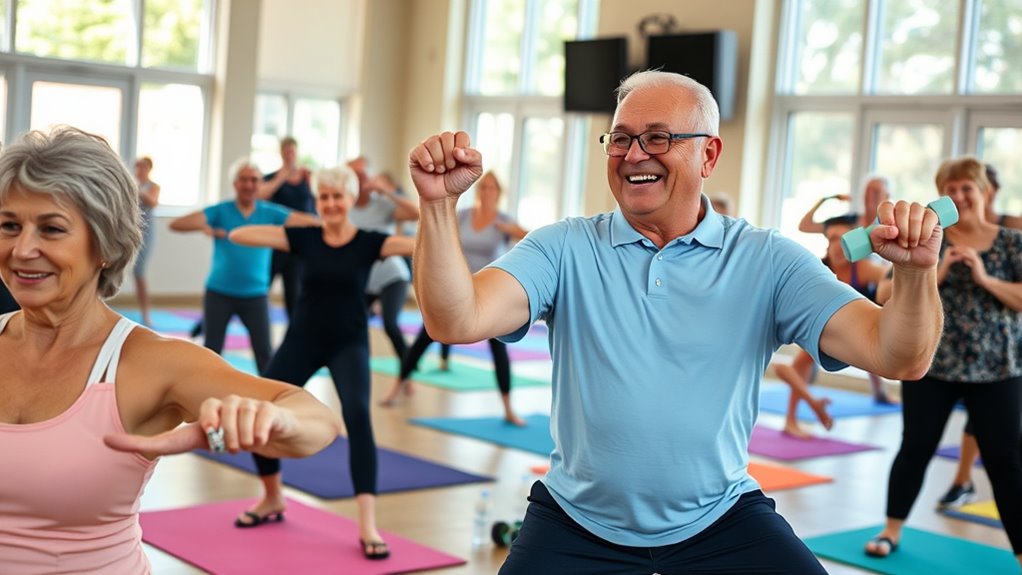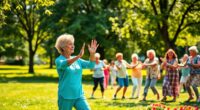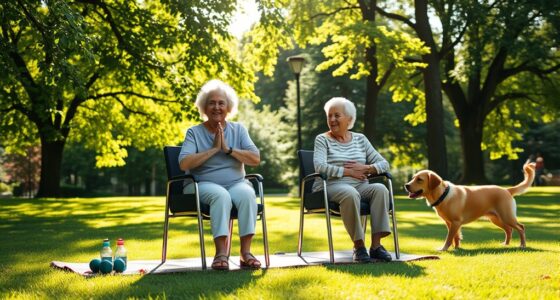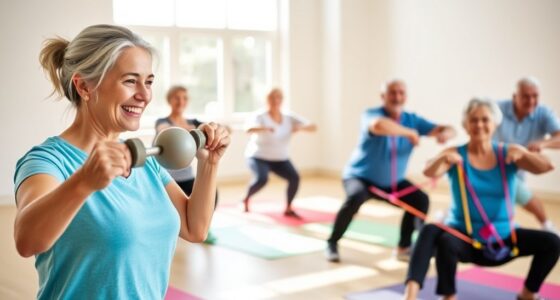To keep you moving strong, start your workout with warm-up exercises like marching in place or step touches for about 5-10 minutes. Incorporate strength training two to three times a week using movements like arm curls and chair stands, which boost balance and coordination. Enhance lower body strength with side leg raises, and always focus on good posture. Remember to stretch afterward and listen to your body for a safe, enjoyable fitness journey. You’ll discover even more tips ahead!
Key Takeaways
- Incorporate warm-up exercises lasting 5 to 10 minutes to prepare muscles and reduce injury risk before workouts.
- Engage in strength training two to three times a week to preserve muscle mass and enhance balance.
- Focus on lower body exercises like side leg raises and chair stands to improve strength and stability.
- Include effective stretching techniques post-workout to enhance flexibility and prevent injuries.
- Maintain good posture and engage core muscles during exercises to ensure safety and maximize performance.
The Importance of Warm-Up Exercises
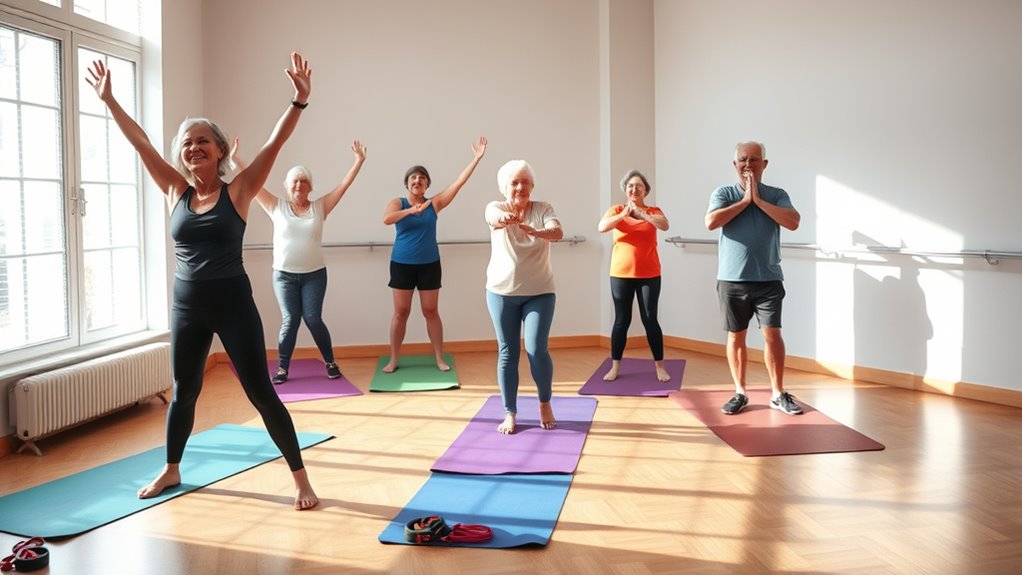
When you start your workout, don’t skip the warm-up, as it’s essential for preparing your body.
Warm-up exercises gradually increase your heart rate and loosen your muscles, reducing the risk of injury. Spend at least 5 to 10 minutes on effective warm-ups, like marching and step touches, to enhance your flexibility and range of motion.
Warm-up exercises are crucial for raising your heart rate and loosening muscles, minimizing injury risk while enhancing flexibility.
Specific techniques, such as seated quad warm-ups and calf stretches, target vital muscle groups, making them more responsive during your workout.
By consistently incorporating warm-up exercises, you’ll not only improve your performance in strength and balance activities but also promote better form and muscle engagement.
This routine leads to long-term gains in your strength training outcomes, keeping you moving strong.
Strength Training for Seniors
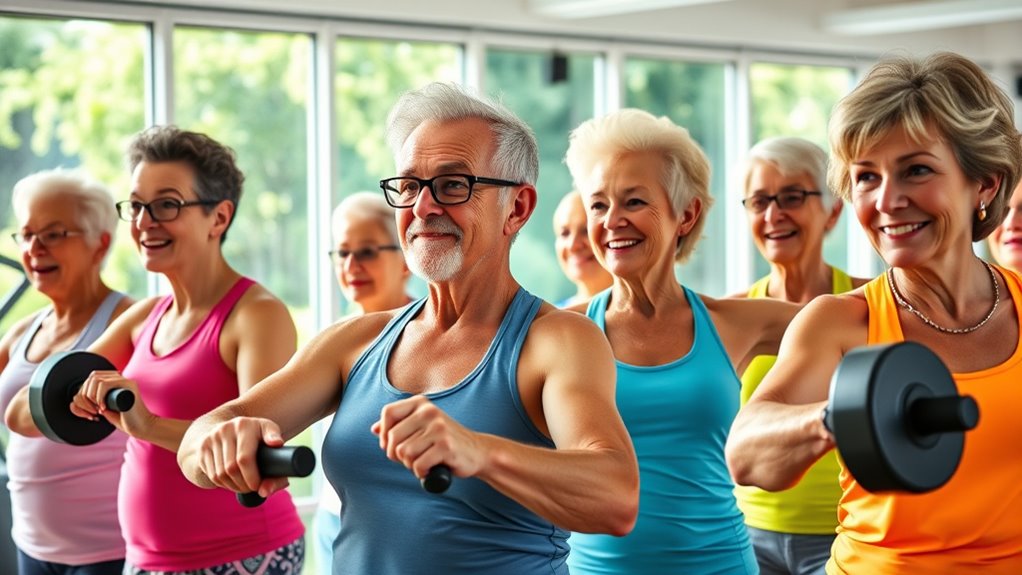
After warming up, it’s time to focus on strength training, which plays an essential role in maintaining your health as you age. Engaging in strength exercises helps preserve muscle mass and bone density, reducing the risk of osteoporosis and frailty. Additionally, understanding financial considerations for elderly care can help you plan for any future health-related expenses associated with maintaining an active lifestyle. Proper planning can also help avoid costly errors related to IRA inheritance rules, ensuring that your financial health is secure as you age. Moreover, considering inflation-protected annuities can provide a stable income to support your fitness activities as you grow older.
It’s crucial to set specific savings goals for your healthcare expenses as you plan for retirement. Simple activities like arm curls and chair stands can vastly improve your functional abilities, making daily tasks easier. Aim to incorporate strength exercises into your routine at least two to three times a week for maximum benefits.
Focus on proper form and posture, and don’t hesitate to use modifications to guarantee you stay safe and effective. A consistent strength training routine also enhances balance and coordination, decreasing the likelihood of falls and injuries as you grow older. Additionally, incorporating balance bikes and scooters into your activity regimen can further improve your coordination and gross motor skills.
Enhancing Lower Body Strength and Balance
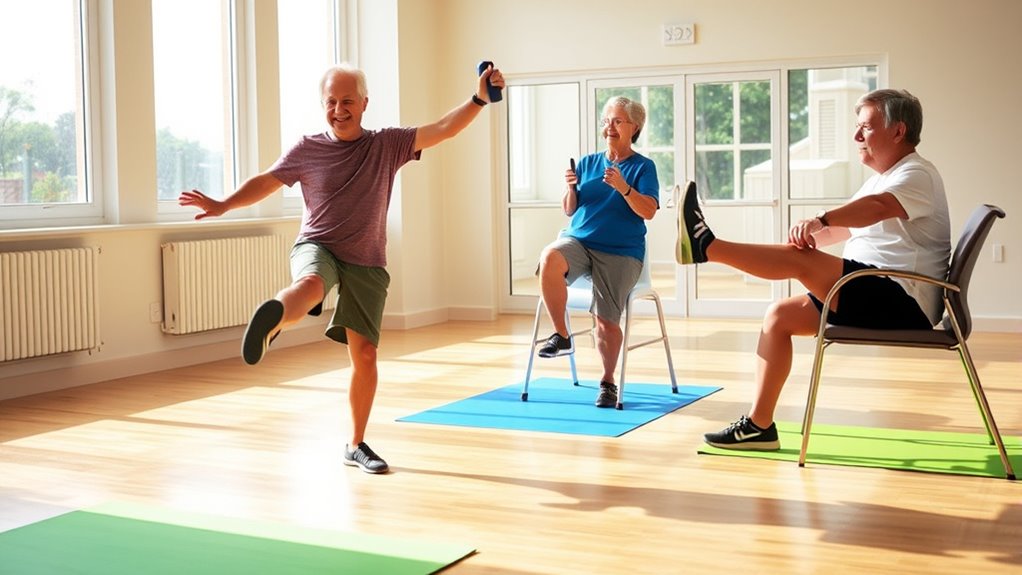
To enhance lower body strength and balance, it is important to incorporate targeted exercises into your routine. Engaging in side leg raises for 10 repetitions per side strengthens your hips and abductors, promoting stability. Additionally, back leg raises focus on your glutes and hamstrings, necessary for mobility and posture. Incorporating these exercises into your routine can be as beneficial as adding best washer brands for overall efficiency and support. By creating transformative living spaces, you can further ensure a safe and comfortable environment for exercising. Remember, regular maintenance is essential for optimal function, akin to the importance of modern toilet functionality issues. Maintaining a healthy level of physical activity is crucial for overall fitness and well-being. Maintain good posture by keeping your legs straight and engaging your core. Hydration and rest are essential to prevent fatigue, ensuring you perform exercises safely and effectively. Regular tick checks post outdoor activities can also help ensure your overall health while staying active.
| Exercise | Benefits |
|---|---|
| Side Leg Raises | Strengthens hips, improves balance |
| Back Leg Raises | Targets glutes, enhances mobility |
| Core Engagement | Supports posture, reduces injury risk |
Effective Stretching Techniques
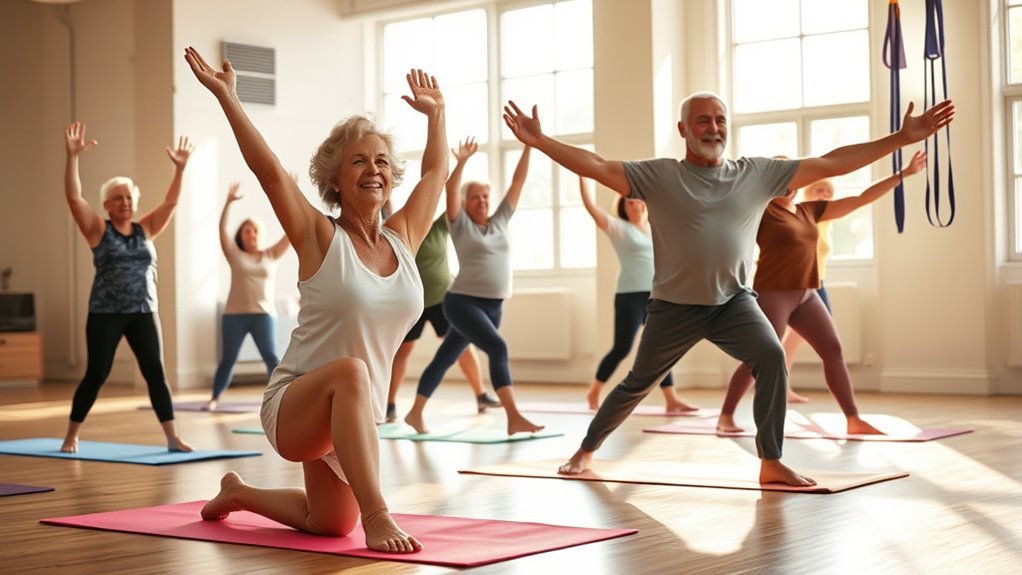
Strengthening your lower body not only boosts your stability but also sets the stage for effective stretching techniques that enhance overall flexibility. Incorporate stretching into your daily routine, holding each stretch for 15 to 30 seconds. This practice improves your flexibility and range of motion over time. For shoulder and triceps stretches, use a towel and lean forward while keeping your elbows close to your head, repeating 3 to 5 times. Additionally, proper stretching techniques can significantly improve your mobility and ease of movement. Post-workout, focus on ankle and calf stretches by pointing your toes and flexing to relieve lower leg tension, all while ensuring your shoulders stay relaxed. Remember to practice proper breathing techniques during stretches to promote relaxation and boost overall effectiveness. Consistent practice helps prevent injuries, making it essential for seniors. Engaging in regular stretching not only enhances flexibility but also supports emotional and psychological growth as part of a holistic approach to well-being. Moreover, temporary hearing loss can sometimes be influenced by physical activity, emphasizing the importance of maintaining overall health through exercise. Furthermore, regular stretching can also contribute to self-protection by alleviating tension that may stem from stressors in life.
Maintaining Good Posture During Workouts

Maintaining good posture during your workouts is essential for preventing injuries and ensuring your body stays properly aligned. By engaging your core muscles and focusing on your stance, you can enhance both safety and performance. Additionally, incorporating mindfulness practices can help you stay aware of your body alignment throughout your routine. Ensuring proper hydration is also crucial as it can affect your overall performance and water requirements during physical activity. Regularly using hydrating serums can support skin health, which is particularly important as you engage in physical activities. Moreover, maintaining indoor air quality can contribute to a healthier workout environment, allowing you to perform at your best. Regular maintenance of air purifiers in your workout space can ensure optimal air quality for your exercise routine.
Let’s explore how proper posture techniques can make a significant difference in your workout routine.
Importance of Posture
Good posture during workouts is essential, especially for seniors, as it helps prevent injuries by keeping your body aligned and reducing strain on muscles and joints. Additionally, practicing good posture can enhance your ability to engage your core, which supports balance and stability during exercise.
Maintaining proper posture not only enhances your workout but also contributes to your overall well-being. Here are three key benefits of good posture during exercise:
- Injury Prevention: Proper alignment reduces the risk of strain on muscles and joints.
- Enhanced Stability: Engaging your core supports balance, vital for avoiding falls.
- Improved Breathing: Keeping your shoulders back and head up promotes better oxygen flow, boosting performance. Moreover, using an air purifier during workouts can help improve indoor air quality, further enhancing your exercise experience.
Core Engagement Techniques
Engaging your core during workouts plays an essential role in keeping good posture and avoiding injuries. By drawing your abdominal muscles in tightly, you’ll stabilize your spine and maintain better form. Remember to keep your feet shoulder-width apart and your elbows tight to your sides.
Here are some core engagement techniques to practice:
| Technique | Description |
|---|---|
| Abdominal Bracing | Tighten your abs as if bracing for a punch. |
| Shoulder Retraction | Pull your shoulders back and down. |
| Head Alignment | Keep your head elevated and in line with your spine. |
| Chair Stands | Stand up from a seated position while engaging your core. |
| Dips | Lower yourself while keeping your core tight. |
Incorporating these techniques enhances your stability and mobility in everyday activities.
Safety and Injury Prevention
To stay safe and prevent injuries during workouts, it’s crucial to focus on your posture. Good posture not only distributes body weight evenly but also reduces strain on your muscles and joints.
Here are three tips to enhance your safety and injury prevention:
- Engage your core: This promotes stability and balance, which is essential for preventing falls.
- Check your alignment: Keep your feet shoulder-width apart and align your knees over your toes to avoid stress on your knees during exercises.
- Practice shoulder retraction: Elevate your head and shoulders to improve posture and encourage better breathing.
Always listen to your body. If something doesn’t feel right, adjust your position or take a break to guarantee you’re moving safely.
Tips for Safe and Enjoyable Exercise Sessions
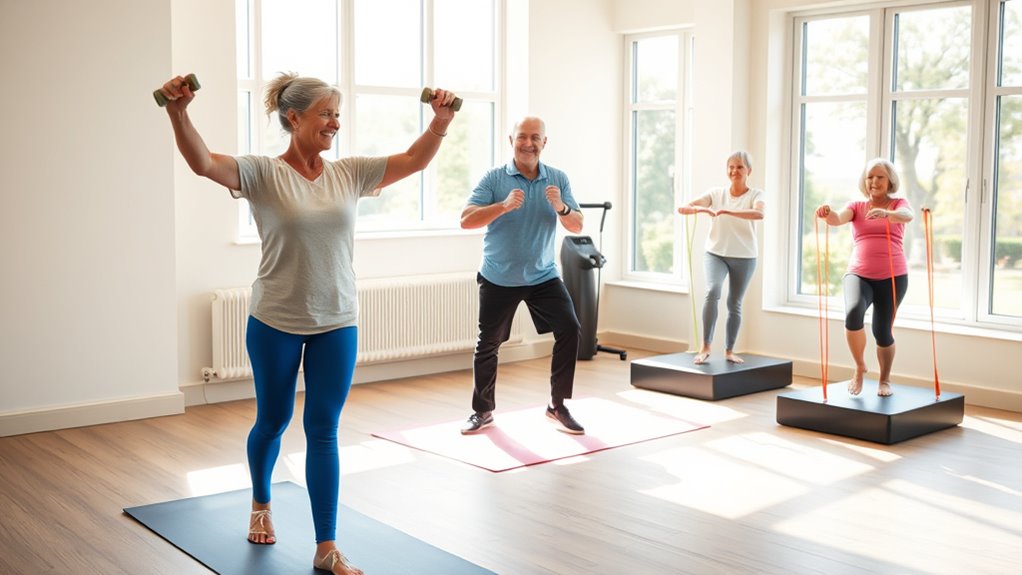
To make your exercise sessions safe and enjoyable, always start with a proper warm-up to get your heart rate up and muscles ready.
Listen to your body and adjust your routine as needed; it’s important to take breaks and stay hydrated.
Plus, focusing on your posture will help you stay stable and prevent injuries during your workouts.
Warm-Up Essentials
Warm-ups are essential for guaranteeing a safe and enjoyable workout session, as they prepare your body for more intensive movements.
Starting your workout with effective warm-ups not only gets your blood flowing but also reduces the risk of injury.
Here are three key warm-up activities you should include:
- March in Place: Raise your heart rate and warm up your muscles.
- Step Touches with Arm Movements: Loosen your shoulders, engage your upper body, and promote good posture.
- Seated Quad Warm-Ups and Calf Stretches: Increase blood flow to your lower body, preparing your legs for strength exercises.
Aim for a warm-up duration of at least 5-10 minutes to guarantee you’re ready for your workout ahead.
Listen to Your Body
Listening to your body is essential for ensuring a safe and enjoyable exercise experience. Always pay attention to how you feel during your workout. If you experience pain or discomfort, modify the movement or take a break as needed.
Hydration is important, so keep water accessible and take sips to stay hydrated. If standard exercises feel too challenging, don’t hesitate to utilize modified versions that allow for a comfortable workout.
Remember, listening to your body also means recognizing when it’s time to rest. Taking breaks is crucial to avoid overexertion and promote recovery.
Focus on Posture
While you engage in your workout, focusing on your posture is essential for maximizing your results and minimizing injury risk. Proper alignment not only enhances your performance but also helps protect you from injuries.
Here are a few tips to keep in mind:
- Maintain Alignment: Keep your feet shoulder-width apart and your elbows close to your sides during arm curls for better form.
- Incorporate Functional Movements: Exercises like chair stands and leg raises promote shoulder retraction and head elevation, boosting your posture.
- Prioritize Stretching: After your workout, use stretching techniques that focus on posture to improve flexibility and range of motion.
Remember to breathe deeply and relax during your exercises to maintain good posture and enjoy your workout more!
Frequently Asked Questions
What Is the Best Overall Exercise for Seniors?
The best overall exercise for you combines strength training, balance exercises, and flexibility routines.
By incorporating resistance exercises like arm curls and chair stands at least twice a week, you can build strength and prevent muscle loss.
Don’t forget balance exercises, such as side leg raises, to reduce fall risk.
Finally, include flexibility training, like stretching, to enhance your range of motion and make daily activities easier and more enjoyable.
Stay active!
What Is the 6 12 25 Rule?
Think of your body as a well-tuned instrument; it needs regular practice to play beautifully.
The 6 12 25 Rule suggests you aim for at least 6 hours of physical activity each week, broken into 12 sessions of 30 minutes.
This rule’s all about mixing strength training, balance, and aerobic exercises.
Following it can boost your muscle strength, flexibility, and overall health, helping you feel vibrant and agile as you age.
What Is the Best Strength Training for a 70 Year Old?
When you’re considering the best strength training for a 70-year-old, focus on low-impact exercises that build muscle without overdoing it.
Think about incorporating body weight movements, resistance bands, or light weights.
Try exercises like arm curls, chair stands, and leg raises to enhance your strength and balance.
Aim for at least two sessions a week, targeting all major muscle groups, and remember to allow for rest days to support recovery.
What Is the Number 1 Exercise to Increase Balance in Seniors?
You’d think the key to balance is mastering yoga poses or fancy dance moves, but it’s actually the simple single-leg stand.
It might seem too easy, but holding this position for just 10 seconds on each leg can really boost your stability.
Challenge yourself by closing your eyes or moving your arms.
Just remember to stand near a wall or chair for safety.
You’ll improve your strength and confidence in no time!
Conclusion
Staying active is essential for your strength and energy as you age. By incorporating warm-ups, strength training, and balance exercises into your routine, you’re not just avoiding the couch potato label, you’re embracing a vibrant lifestyle. Remember to stretch and maintain good posture to keep your body feeling great. With these tips, you can enjoy safe, effective workouts that keep you moving strong. So lace up those sneakers and get ready to feel like a rock star!
